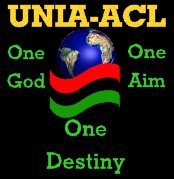 |
UNIA HistoryPage 1 |
| Marcus Mosiah Garvey was born in St. Ann's Bay parish of St. Ann on August 17, 1887. He was the youngest of his fathers 11 children, nine of whom died in childhood. Garvey attended infant and elementary schools in St. Ann's Bay and was a bright student. He also received private tuition from his godfather Mr. Alfred Burrowes, who ran a printery. At 14, Garvey was apprenticed to Mr. Burrowes to learn the printing trade. | |
| Young Garvey inherited a love of books from his father, a skilled mason, who was widely read and had a private library. This love was further encouraged during his apprenticeship as Mr. Burrowes also had an extensive book collection of which Marcus, by now an avid reader, made full use. He also came into contact with the many persons who stopped at the printery to discuss politics and social affairs with Mr. Burrowes. Thus began his lifelong interest in politics and social affairs. |
|
| Around 1906 Garvey left St. Ann's Bay for Kingston in search of brighter prospects. He worked at first with a maternal uncle, then moved on to P.A. Benjamin Limited where he worked as a compositor in the printing section. By the age of 20, in 1907, he had become a master printer and foreman at this company. His first experience in labour organization came with a strike in late 1908 when printers, represented by the Typographical Union, went on strike for better wages. Garvey joined the strike in spite of his being offered increased wages. The strike was unsuccessful and Garvey lost his job. As he was blacklisted he was unable to find a job in a private printery but found employment at the Government Printing Office. |
|
| Garvey left Jamaica to work in Costa Rica as a time-keeper on a banana plantation, in about 1910. As he observed the conditions under which his fellow blacks worked, Garvey became determined to change the lives of his people. He left Costa Rica and travelled throughout Central America, working and observing the working conditions of blacks throughout the region. He visited the Panama Canal Zone and saw the conditions under which the West Indians lived and worked. He went to Ecuador, Nicaragua, Honduras, Colombia and Venezuala. Everywhere, blacks were experiencing great hardships. Garvey returned to Jamaica distressed at the situation in Central America, and appealed to Jamaica's colonial government to help improve the plight of West Indian workers in Central America. His appeal fell on deaf ears. In 1912, Garvey went to London, again working and observing the conditions of blacks in other parts of the British Empire. There, he learnt a lot about African culture and also became interested in the conditions of blacks in the United States. |
|
Garvey's journalistic experience began with a newspaper called The Watchman which he started in 1910 while still employed at P.A. Benjamin Limited. This newspaper was short-lived and was succeeded by others, also of short life spans, which Garvey published during his early Central American travels:
The most successful and important paper was the weekly, Negro World, which ran from 1918 to 1933, in Harlem. The paper promoted Garvey's nationalist ideals and was an avenue of expression for blacks during the years of the Harlem Renaissance. French and Spanish language sections were included in the paper which in August 1920, claimed a circulation of 50,000. |
|
|
Garvey returned to Jamaica in 1914, stirred and ready for action. Convinced that Unity was the only way to improvement for blacks, Garvey launched, on August 1, 1914, the Universal Negro Improvement and Conservation Association and African Communities League. He was President of the association . With the motto "One God! One Aim! One Destiny!", the association sought to unite "all the people of African ancestry of the world into one great body to establish a country and Government absolutely their own." Among the objectives of the association, which became known as the UNIA, were:
The first headquarters of the association was located at 30 Charles Street in Kingston. Later, the association operated from the St. Mark's School, West Street until premises at 76 King Street were brought to house Kingston's Liberty Hall. UNIA offices worldwide were known as Liberty Hall. |
|
| Garvey left for the United States in 1916 to undertake a lecture tour of that country. However, as it turned out he resided there until 1927 when he was deported. During this period, he worked assiduously to build and consolidate the UNIA into a truly international organization. His efforts were successful, and by 1920, the association boasted over 1,100 branches in more than 40 countries. Most of these branches were located in the United States, which had become the UNIA's base of operations. There were, however, offices in several Caribbean countries, Cuba having the most. Branches also existed in places such as Panama, Costa Rica, Ecuador, Venezuela, Ghana, Sierra Leone, Liberia, Namibia and South Africa. |
|
| UNIA Auxilliary Groups To further unite people of African ancestry and prepare them for self-reliance and mass action if necessary, auxilliary groups were formed within the UNIA. The African Legion, the Black Cross Nurses, The Universal Motor Corps, all uniformed groups, helped to foster dignity and self-worth in adults. A juvenile auxilliary served the same purpose for black youth. |